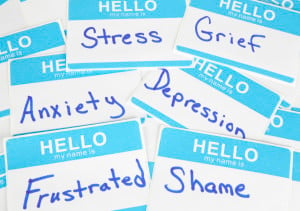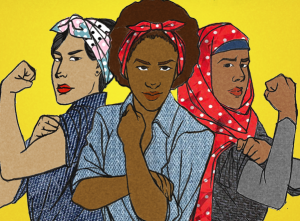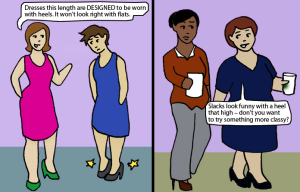
Person standing against a wall looking directly at the camera
If you grew up Latinx in the United States, you might have spent your most formative years going to church with your abuelita — not talking openly about sex or relationships with your parents.
I was raised in a very Catholic, Mexican-American family.
My Catholic school education included lectures by religion teachers about the dangers of sharing a blanket with someone of a different gender, saving your virginity for Christ, and having our skirts measured in front of the entire class.
Outside of warnings, admonitions, or abstinence-only lectures, my experience learning about sexuality was defined by deafening silence.
As a girl, I learned the world was dangerous for me. I experienced street harassment and sexualization from a young age. The spectres of rape and kidnapping were ever-present.
My friends and I were aware that we were vulnerable to being harmed. We experienced sexually aggressive or harassing behavior from adults, adolescent men, and young boys alike — an experience shared by many Latinas and women of color across the United States.
The informal lessons that Latinx youth are sometimes taught about sex and sexual violence often rely on now disproven myths about rape.
We were taught we should be most careful around strangers, that family is where we are safest, and that the assaulted girls we heard about on the news or by word of mouth were somehow to blame for sex that was forced on them.
Why then, did I feel so uncomfortable in my own neighborhood and my own school, around boys and men in my own community? What effect does the constant fear of sexual violence have on Latinas and, in turn, the community as a whole?
In Latinx homes, talks about sex tend to focus on abstaining from sex for as long as possible. And, outside of the home, Latinxs across the country lack access to comprehensive health care, formal sex education, and family planning services.
How can we learn about safe sex, healthy relationships, consent, and boundaries if we don’t have these conversations at home, at school, or even through health services?
Often, when Latinxs envision futures free from violence, we fail to see rape and abuse as a crucial part of the problem.
Much of our activism is focused on surviving white supremacy and institutionalized oppression in its many forms — labor struggles, mass detention, xenophobia, gentrification, and police brutality — but our activism does not always discuss our internal struggles with sexual and gender-based violence.
In honor of the Latinx survivors who have spoken — and continue to speak — out against assault, our communities must begin placing sexual and interpersonal violence at the center of our healing work.
Since the biggest battles are often waged at home, it’s important to bring in accessible information about sexual assault and domestic violence that your loved ones may not have known before.
If we are going to do the deep work of liberation, we must start with ourselves and the people we love most: our chosen and biological families.
But how do we begin to have these difficult conversations?
Myth Busting
Myth-busting and local involvement are two great ways to begin the conversation about sexual violence with your Latinx family and community.
I have memories of seeing stories of missing, murdered, or assaulted muxeres on the news and hearing victim-blaming comments from reporters, law enforcement, or family watching the programming.
It can be frustrating to hear victim blaming or rape apologist language and not having the right words to say. But talking about the realities of sexual violence and modeling supportive language for survivors in front of Latinx friends and family helps introduce new knowledge around these issues.
Here are 10 common myths and misconceptions about sexual violence that I’ve heard from my Latinx family, friends, community, and clients, and some ideas for how to respond:
1. Myth: Rapists are strange men who attack women in dark alleys and parking lots.
Reality: The majority of sexual assaults are perpetrated by someone that the survivor knows and take place in familiar environments. Attackers can be people that we trust and are comfortable being alone with, such as family members, romantic partners, friends, coaches, classmates, and trusted leaders in the community.
2. Myth: Only adult men can commit sexual assault.
Reality: Although the majority of sexual assaults are committed by cisgender heterosexual men, harm-doers can be of any gender, race, or ethnicity; ANYONE can be a victim or a perpetrator of sexual violence.
3. Myth: Women and girls that get raped were probably “flirting” or “asking for it”.
Reality: Nobody asks to be sexually assaulted. When we blame survivors for the assault perpetrated against them, we take responsibility away from the attacker. A consequence of machismo, muxeres are often held responsible for the actions of men.
4. Myth: Abused children don’t need to talk about what happened to them. Children will forget and therapy further traumatizes them.
Reality: Latinx parents of abused children sometimes believe that their children do not need to talk about the abuse because they are too young to understand what happened to them. Unfortunately, many child survivors of sexual abuse do not receive services because of these beliefs. And yet, studies show that abused children are more likely to develop mental health problems later in life, especially if they don’t get the help they need.
5. Myth: Men and boys cannot be abused or assaulted.
Reality: ANYONE can be a victim of sexual abuse or assault. It is estimated that 1 out of every 6 men has survived sexual abuse or assault in their lifetime. Because of social stigma around sexual assault, homophobia — due to machismo — Latino survivors of assault are less likely to disclose what happened to them or seek out help.
6. Myth: She deserved to be assaulted because she’s a “puta” or “cualquiera.”
Reality: Slut shaming is violence. No one deserves to be abused or assaulted, and referring to someone as a slut, hoe, puta or cualquiera suggests that she has no boundaries, no autonomy, and does not have the right to say no to sex no matter the circumstances. Too often in Latinx families, especially highly religious ones, when women have sex outside of marriage or engage in casual sex, they are seen as sexually and morally deviant and undeserving of love, care, or protection.
7. Myth: Survivors exaggerate and lie about rape.
Reality: When Latinx survivors try to disclose abuse or assault, they are sometimes told that they are lying, exaggerating, or imagining things. The reality is that survivors very rarely lie about abuse or assault. The rate of false reporting for sexual assault is the same as every other crime: approximately 2%.
8. Myth: Children don’t know enough about sex to commit sexual assault.
Reality: More than one-third of childhood sexual abuse is committed by another child under the age of 18. When children abuse other children it is usually because that perpetrating child was also harmed or abused in the past. In my work as a sexual assault advocate, I have worked with several Latinx children who had been molested by a cousin, classmate, or sibling.
9. Myth: We are safest when we are with our families or communities.
Reality: Unfortunately, homes and community spaces are sometimes where people face the most abuse. We repeatedly see families and communities rallying around abusers to protect them from negative consequences while ignoring or dismissing the safety of survivors.
When we shield attackers from accountability or consequences, we also push survivors out of their positions within their families, schools, and communities. Sometimes, survivors are pushed out and abusers are embraced under the guise of “keeping the family together.”
10. Myth: Sexual assault happens in isolation.
Reality: Sexual violence often intersects with other forms of violence and oppression. Immigrant muxeres have often spoken out against the sexual violence they face at work and have led struggles against workplace sexual violence. Fights against labor inequality, xenophobia, and mass incarceration should always include tackling sexual violence as a crucial component of liberation from oppressive systems.
In addition to talking to our families and communities about the myths and realities of sexual violence, there are other ways to get involved and directly help survivors to heal.
If you are interested in joining the fight to end sexual violence in Latinx communities, here are 5 ways that you can get involved:
Get Involved
1. Student Activism
If you are in school, look for opportunities to do projects and research related to sexual violence. Sexual assault continues to be one of the most underreported crimes in the United States and there is still limited information about how sexual violence plays out, especially in Latinx and immigrant communities.
It’s important for us to know as much as possible about the particularities of sexual violence in our communities, and learning more can make a big difference.
2. Volunteer
If you are interested in volunteering to work directly with survivors and community members, there are a number of different volunteer programs that exist across the country. And since many Latinxs in the U.S. are bilingual, our language skills can be invaluable and we can help both Spanish and English-speaking survivors of violence.
Crisis hotlines are always in need of multilingual counselors and advocates to help survivors find emergency shelter, seek out restraining orders, create safety plans, and so much more. Contact your local rape crisis center or domestic violence agency; many agencies have opportunities to volunteer on a crisis hotline, as an advocate, and as community health educators.
3. Speak up
If you are concerned about sexual violence in your community, check out local neighborhood meetings, collectives, civic groups and voice your concerns. Find out when your City Council meets, attend School Board Meetings, and make sexual violence a topic of concern.
4. Vote
Keep up with your local politics. If you are old enough to vote, you can choose to use your vote in order to support legislation which allocates more funding to services for survivors.
5. Donate
Consider giving money directly to survivors you know who need help getting back on their feet. Survivors of sexual violence often face huge financial barriers. Assault and abuse can actually be very costly and place survivors in economic hardship — contrary to popular belief, there is no money to be gained by reporting assault.
You can also choose to donate to your local crisis hotline, rape crisis center, or domestic violence shelter if you would like to support healing resources for survivors.
***
It is my firm belief that community healing, success, and liberation will not be possible for Latinxs while community members are subjected to rampant sexual and interpersonal violence.
Engaging in open and educational dialogues with our families and friends about the myths and realities of sexual violence can be difficult, but it is also a giant step towards healing.
By encouraging support for survivors and accountability for harm doers, we create an understanding that the lives of vulnerable and marginalized folks are not disposable.
When survivors thrive, so too can their communities.
[do_widget id=’text-101′]
Mala Muñoz is an Everyday Feminism Reporting Fellow. Mala is a writer, advocate, and crisis counselor from Los Angeles. Her writing has been featured in VIBE Magazine’s online Latinx platform, VIBE Viva, and the HuffPost Blog. A third generation Xicana and one half of the podcast Locatora Radio, Mala’s work, online and in real life, focuses on the creativity, genius, and legacies of women and survivors of color.
Search our 3000+ articles!
Read our articles about:
Our online racial justice training
Used by hundreds of universities, non-profits, and businesses.
Click to learn more




















